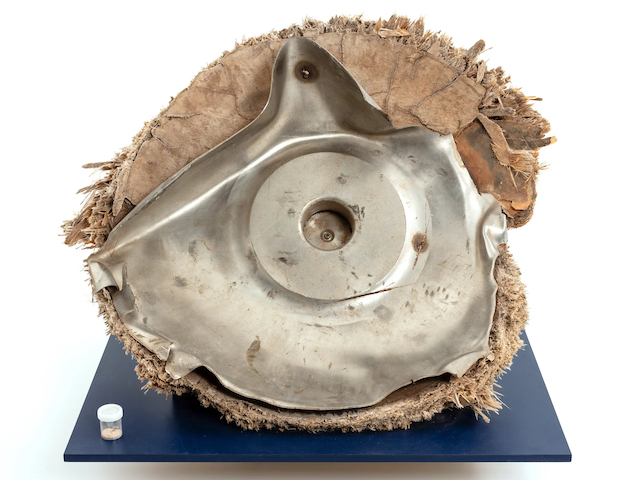
Skylab: The Space Station That Fell on Australia
Repaired during one of the riskiest missions ever, it orbited for 6 years
By ALLISON MARSH 30 APR 2023

A cattle rancher found this chunk of Skylab more than a decade after the space station reentered Earth’s atmosphere on 12 July 1979. PHOTO: RYAN HERNANDEZ; OBJECT: POWERHOUSE COLLECTION
Fifty years ago, on 14 May 1973, a modified Saturn V rocket launched from the Kennedy Space Center carrying Skylab, the United States’ first space station. Six years later, in the early hours of 12 July 1979, Skylab reentered Earth’s atmosphere in a fiery blaze, spreading debris across the Indian Ocean and Western Australia. More than a decade later, a rancher found this end cap from one of Skylab’s oxygen tanks in the dirt. Cattle were drinking collected rainwater from the remains of a US $2.2 billion NASA investment.
Skylab’s Failure and Recovery
Skylab’s fate was sealed moments after lift-off when the sun shield and main solar panel were severely damaged, making it questionable whether the spacecraft could fulfill its multiple planned missions. Without the sun shield, which also protected against small meteoroid damage, the internal temperature of the module would rise to uninhabitable temperatures. The damaged solar panels could not generate enough electricity to power the space station.
 Skylab launched as a single, two-story unit that combined living quarters with a workshop. It included hundreds of science experiments, a solar observatory, and even a device for taking in-flight showers. The human crew was scheduled to go up a day after the spacecraft. Within hours of the Skylab failure, NASA delayed that crewed mission, as engineers hustled to assess the damage and suggest repairs. The space agency had only a short window of opportunity to salvage the mission. As the cabin overheated, food would begin to spoil, photographic film would be damaged, and materials would begin to break down and off-gas, making the air unbreathable.
Skylab launched as a single, two-story unit that combined living quarters with a workshop. It included hundreds of science experiments, a solar observatory, and even a device for taking in-flight showers. The human crew was scheduled to go up a day after the spacecraft. Within hours of the Skylab failure, NASA delayed that crewed mission, as engineers hustled to assess the damage and suggest repairs. The space agency had only a short window of opportunity to salvage the mission. As the cabin overheated, food would begin to spoil, photographic film would be damaged, and materials would begin to break down and off-gas, making the air unbreathable.
Skylab’s sun shield, shown here dangling by a thin strap, was
damaged during launch. NASA
NASA engineer Jack Kinzler suggested a solar shield designed like an umbrella that could be deployed through a 20-centimeter-square port hole near the site of the damage and then opened up to provide shade. Once the proof of concept was approved, engineers raced against time to manufacture the device while the Skylab crew began training on how to make the necessary repairs.
This article first appeared at IEEE Spectrum on April 30, 2023.
No Comments




